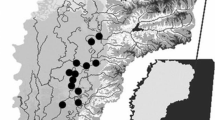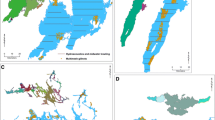Abstract
Water quality may be significantly determined by water quantity. Lake Chapala, México is a large lake beset with numerous water quality problems. The decline in water volume over the past 20 years, a serious problem itself, is associated with causing or enhancing several problems of quality. Five such problems are explored herein. These are: extensive infestations of water hyacinth (Eichhornia crassipes), a declining native fishery, light limitation of phytoplankton production at the base of the food chain, shallow-water algal blooms resulting in water supply treatment problems, and the presence of toxic metals in the harvested and sold fishes.
Similar content being viewed by others
References
Barbour, C., 1973. A biogeographical history of Chirostoma (Pisces: Atherinidae): A species flock from the Mexican plateau. Copeia 3: 533–556.
Becerra-Muñoz, S., H. Buelna-Osben, J., J. Catalan-Romero & A. Mejia-Muratalla, 1997. The atherinidae and goodeidae fish community as an indicator of ecosystem health. 5th International Conference on Aquatic Ecosystem Health: Linking Science, Education, Politics and Society. October 26-29, Ajijic, Jalisco, Mexico.
Berman, T., A. Nishri, A. Parparov, B. Kaplan, S. Chava, M. Schlicter & U. Pollingher, 1997. Relationships between water quality parameters and water levels in Lake Kinneret. Verh. Internat. Verein. Limnol. 26: 671–674.
Clements, T., 1963. Pleistocene history of Lake Chapala Jalisco, Mexico. Essays in Marine Geology in Honor of K. O. Emery. Univ. Calif. Press, Los Angeles.
Dávalos-Lind, L., 1996. Phytoplankton and bacterioplankton stress by sediment-borne pollutants. J. Aquat. Ecosyst. Health 5: 99–105.
Dávalos, L., O. Lind & R. Doyle, 1989. Evaluation of phytoplankton-limiting factors in Lake Chapala, Mexico: Turbidity and the spatial and temporal variation in algal assay response. Lake Reservoir Mgmt. 5: 99–104.
Dávalos-Lind, L., O. Lind, R. Sada, A. Guerra, G. Velarde, L. Orozco & T. Chrzanowski, 1992. La producción bacteriana y su importancia en la cadena trófica. Ingeniería Hidráulica en México 7: 30–26.
Ford, T. & D. Ryan, 1995. Toxic metals in aquatic ecosystems: a microbiological perspective. Environ. Health Perspect 103 (Suppl. 1): 25–28.
Hansen, A., 1992. Metales pesados en sl sistema Lerma-Chapala: distribución y migración. Ingeniería Hidráulica en México. Mayo-Diciembre: 92–98.
Hutchinson, C., P. Warshall, E. Arnould & J. Kindler, 1992. Development in arid lakes: lessons from Lake Chad. Environment 34: 16–20.
Jones, J. & M. Hoyer, 1982. Sportfish harvest predicted by summer chlorophyll-a concentration in midwestern lakes and reservoirs. Trans. am. Fish. Soc. 111: 176–179.
Limón, J. & O. Lind, 1990. The management of Lake Chapala (México): Considerations after significant changes in the water regime. Lake Reservoir Mgmt. 6: 61–70.
Limón, J. G., O. T. Lind, D. S. Vodopich, R. D. Doyle & B. G. Trotter, 1989. Long-and short-term variation in the physical and chemical limnology of a large, shallow, turbid tropical lake (Lake Chapala, Mexico). Arch. Hydrobiol. 83 (Monogr. Beit.) 1: 57–83.
Lind, O., T. Chrzanowski & L. Dávalos-Lind, 1997. Clay turbidity and the relative production of bacterioplankton and phytoplankton. Hydrobiologia 353: 1–18.
Lind, O., L. Dávalos-Lind, T. Chrzanowski & J. Limón, 1994. Inorganic turbidity and the failure of fishery models. Int. Revue ges. Hydrobiol. 79: 7–16.
Lind, O., R. Doyle, D. Vodopich, B. Trotter, J. Limón & L. Dávalos-Lind, 1992. Clay turbidity: governing of phytoplankton production in a large, nutrient-rich tropical lake (Lago de Chapala, México). Limnol. Oceanogr. 37: 549–565.
Lyons, J., G. Gonsalez, E. Soto & M. Guzman, 1998. Decline of freshwater fishes and fisheries in selected drainages of westcentral México. Fisheries 23: 10–18.
Melack, J., 1976. Primary productivity and fish yields in tropical lakes. Oecologia 44: 1–7.
Oglesby, R., 1977. Relationships of fish yield to lake phytoplankton standing crop, production and morphoedaphic factors. J. Fish. Res. Bd Can. 34: 2271–2279.
Parija, P., 1934. Physiological investigations on water hyacinth (Eichhornia crassipes) in Orissa with notes on some other aquatic weeds. Indian J. Agricultural Sci. 4: 399–429.
Pomeroy, C., 1993. Organized fishers' responses to social dilemmas of common pool resource use PhD dissertation, Texas A & M Univ: 175 pp.
Pomeroy, C., 1994. Obstacles to institutional development in the fishery of Lake Chapala, Mexico. In Dyer, C. & J. McGoodwin (eds), Folk Management in the World's Fisheries. Lessons for Modern Fisheries Management. U. Colorado Press: 17–41.
Ryder, R., 1965. A method of estimating fish production in northtemperate lakes. Trans. am. Fish. Soc. 94: 214–218.
Shine, J., D. Ryan & T. Ford, 1998. Annual cycle of heavy metals in a tropical lake — Lake Chapala, Mexico. J. Environ. Sci. Health, Part A 33: 23–43.
Simons, T., 1980. Circulation models of lakes and inland seas. Can J. Fish. Aquatic. Sci. 203: 1–146.
Soto-Galera, E., E. Diaz-Pardo, E. Lopez-Lopez & J. Lyons, 1998. Fish as indicators of environmental quality in the Rio Lerma Basin, México. Aquat. Ecosyst. Health Mgt. 1: 267–276.
Stone, R., 1999. Coming to grips with Aral Sea's grim legacy. Science 284: 33–33.
Author information
Authors and Affiliations
Rights and permissions
About this article
Cite this article
Lind, O.T., Dávalos-Lind, L. Interaction of water quantity with water quality: the Lake Chapala example. Hydrobiologia 467, 159–167 (2002). https://doi.org/10.1023/A:1014902630410
Issue Date:
DOI: https://doi.org/10.1023/A:1014902630410




